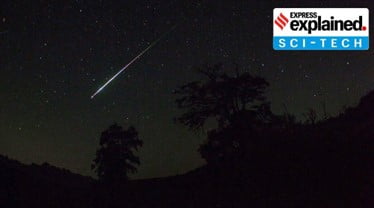Science and Technology
In News: This year, the Geminids will peak around December 13-14, when, with a clear sky and away from bright city lights, you can watch scores of meteors streak across the sky.
- This year however, the moon is bright, and so only 30-40 meteors per hour will be visible in the Northern Hemisphere.
What are meteor showers:

- Meteors come from leftover comet particles and bits from asteroids
- Meteors are usually fragments of comets.
- As they enter the Earth’s atmosphere at high speed, they burn up, creating a spectacular “shower”.
- When these objects come around the Sun, they leave a dusty trail behind them.
- Every year Earth passes through these debris trails, which allows the bits to collide with our atmosphere where they disintegrate to create fiery and colourful streaks in the sky
About Geminids:
- One of the best and most reliable annual meteor showers
- With new moon and clear weather, the Geminids can produce approximately 100-150 meteors per hour for viewing.
- The Geminids are unique because unlike most meteor showers, they originate not from a comet, but from an asteroid –3200 Phaethon.
- As the 3200 Phaethon moves close to the Sun while orbiting it, the rocks on its surface heat up and break off.
- When the Earth passes through the trail of this debris, the Geminids are caused.
- The name Geminids – from constellation Gemini, from whose location in the sky the meteor shower appears to originate.
- It serves to aid viewers in determining which shower they are viewing on a given night.
- The constellation is not the source of Geminids.
- Geminids are visible throughout the night sky, not just in Gemini constellation
How to watch:
- Chances of a successful viewing are higher from locations far away from the lights of cities.
- Generally, pollution makes viewing meteor showers from India difficult.
- But in areas where there is no light or air pollution, viewers do not need to use any special equipment to view the showers.
- Make sure to give your eyes enough time to adjust to the darkness, which can take about 30 minutes.
- Additionally, viewers should try to stay away from their phones, as looking at bright screens affects night vision.
Asteroid 3200 Phaethon:
- Discovered on October 11, 1983.
- Named after the Greek mythology character Phaethon, son of the Sun God Helios.
- It takes 4 years to complete one round of the Sun.
Miscellaneous:
- Gemini constellation is located northeast of the constellation Orion and between the Taurus and Cancer constellations.
Source: Indian Express
Previous Year Questions
Q.1) What is difference between asteroids and comets? (2011)
- Asteroids are small rocky planetoids, while comets are formed of frozen gases held together by rocky and metallic material.
- Asteroids are found mostly between the orbits of Jupiter and Mars, while comets are found mostly between Venus and mercury.
- Comets show a perceptible glowing tail, while asteroids do not.
Which of the statements given above is/are correct?
- 1 and 2 only
- 1 and 3 only
- 3 only
- 1, 2 and 3











